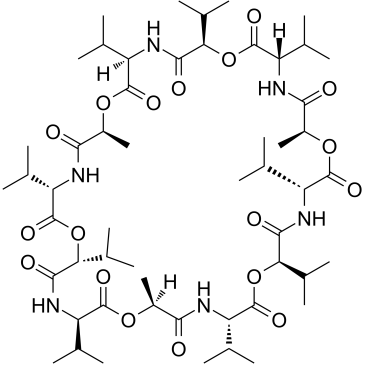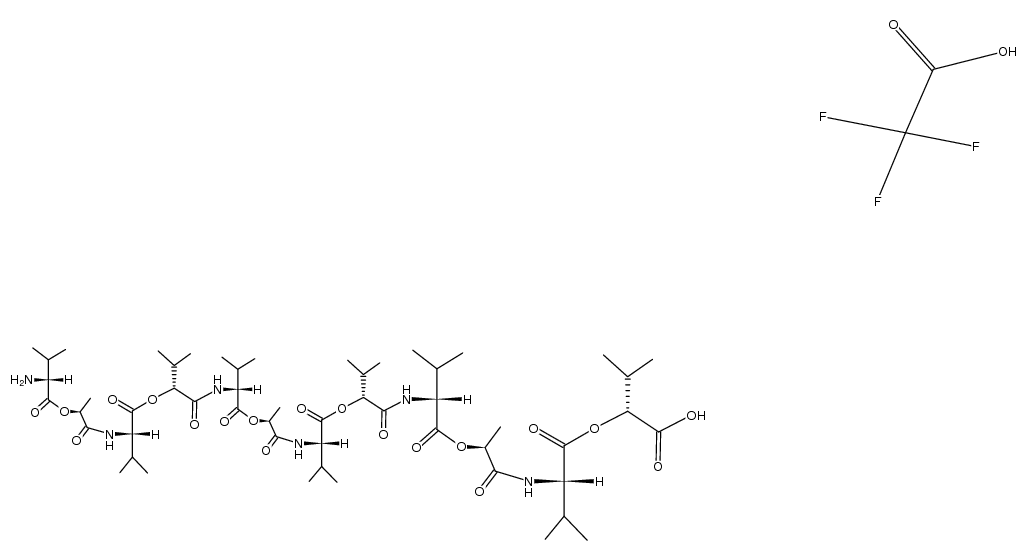2001-95-8
| 中文名 | 缬氨霉素 |
|---|---|
| 英文名 | valinomycin |
| 中文别名 | 氨基霉素 |
| 英文别名 |
(3S,6S,9R,12R,15S,18S,21R,24R,27S,30S,33R,36R)-6,18,30-trimethyl-3,9,12,15,21,24,27,33,36-nona(propan-2-yl)-1,7,13,19,25,31-hexaoxa-4,10,16,22,28,34-hexaazacyclohexatriacontane-2,5,8,11,14,17,20,23,26,29,32,35-dodecone
Valinomycin antibioticn-329b valinomicin 1,7,13,19,25,31-Hexaoxa-4,10,16,22,28,34-hexaazacyclohexatriacontane-2,5,8,11,14,17,20,23,26,29,32,35-dodecone, 6,18,30-trimethyl-3,9,12,15,21,24,27,33,36-nonakis(1-methylethyl)-, (3S,6S,9R,12R,15S,18S,21R,24R,27S,30S,33R,36R)- EINECS 217-896-6 Valinomycin,Cyclo(D-α-hydroxyisovaleryl-D-valyl-L-lactoyl-L-valyl-D-α-hydroxyisovaleryl-D-valyl-L-lactoyl-L-valyl-D-α-hydroxyisovaleryl-D-valyl-L-lactoyl-L-valyl) Cyclo(D-α-hydroxyisovaleryl-D-valyl-L-lactoyl-L-valyl-D-α-hydroxyisovaleryl-D-valyl-L-lactoyl-L-valyl-D-α-hydroxyisovaleryl-D-valyl-L-lactoyl-L-valyl) (3R,6R,9S,12S,15R,18R,21S,24S,27R,30R,33S,36S)-3,6,9,15,18,21,27,30,33-Nonaisopropyl-12,24,36-trimethyl-1,7,13,19,25,31-hexaoxa-4,10,16,22,28,34-hexaazacyclohexatriacontane-2,5,8,11,14,17,20,23,26,29,32,35-dodecone BU 226 hydrochloride Cyclo(D-a-hydroxyisovaleryl-D-valyl-L-lactoyl-L-valyl-D-a-hydroxyisovaleryl-D-valyl-L-lactoyl-L-valyl-D-a-hydroxyisovaleryl-D-valyl-L-lactoyl-L-valyl) MFCD00005114 |
| 描述 | Valinomycin (NSC 122023) 是一种环状缩酚肽类抗生素,最初从 Streptomyces fulvissimus 中分离得到,是一种钾离子选择性运输载体。Valinomycin (NSC 122023) 通过影响生物膜抑制淋巴细胞的扩增,能诱导 CHO 细胞凋亡。 |
|---|---|
| 相关类别 | |
| 参考文献 |
| 密度 | 1.1±0.1 g/cm3 |
|---|---|
| 沸点 | 1333.9±65.0 °C at 760 mmHg |
| 熔点 | 186-190ºC |
| 分子式 | C54H90N6O18 |
| 分子量 | 1111.322 |
| 闪点 | 760.5±34.3 °C |
| 精确质量 | 1110.631104 |
| PSA | 332.40000 |
| LogP | -2.08 |
| 外观性状 | 白色固体 |
| 蒸汽压 | 0.0±0.3 mmHg at 25°C |
| 折射率 | 1.449 |
| 储存条件 | 密封、在2 ºC -8 ºC下保存 |
| 稳定性 | 如果遵照规格使用和储存则不会分解,未有已知危险反应,避免氧化物 |
| 计算化学 | 1、 疏水参数计算参考值(XlogP):9.1 2、 氢键供体数量:6 3、 氢键受体数量:18 4、 可旋转化学键数量:9 5、 互变异构体数量:24 6、 拓扑分子极性表面积(TPSA):332 7、 重原子数量:78 8、 表面电荷:0 9、 复杂度:1910 10、同位素原子数量: 0 11、确定原子立构中心数量:12 12、不确定原子立构中心数量:0 13、确定化学键立构中心数量:0 14、不确定化学键立构中心数量:0 15、共价键单元数量:1 |
| 更多 | 1. 性状:粉末 2. 密度(g/mL,25ºC):未确定 3. 相对蒸汽密度(g/mL,空气=1):未确定 4. 熔点(ºC):190 5. 沸点(ºC):未确定 6. 沸点(ºC,0.8mmHg):未确定 7. 折射率:未确定 8. 闪点(°C):未确定 9. 比旋光度(ºF):31 10. 自燃点或引燃温度(ºC):未确定 11. 蒸气压(kPa,25ºC):未确定 12. 饱和蒸气压(kPa,110ºC):未确定 13. 燃烧热(KJ/mol):未确定 14. 临界温度(ºC):未确定 15. 临界压力(KPa):未确定 16. 油水(辛醇/水)分配系数的对数值:未确定 17. 爆炸上限(%,V/V):未确定 18. 爆炸下限(%,V/V):未确定 19. 溶解性:难溶解于水的 |
Synonym:None Known Section 2 - COMPOSITION, INFORMATION ON INGREDIENTS
Risk Phrases: 27/28 Section 3 - HAZARDS IDENTIFICATION EMERGENCY OVERVIEW
Very toxic in contact with skin and if swallowed.Highly toxic. Potential Health Effects Eye: May cause eye irritation. Skin: May cause skin irritation. May be fatal if absorbed through the skin. Ingestion: May be fatal if swallowed. May cause irritation of the digestive tract. May cause cardiac disturbances. May cause central nervous system depression. Inhalation: May cause respiratory tract irritation. May cause cardiac abnormalities. Inhalation at high concentrations may cause CNS depression and asphixiation. Chronic: Effects may be delayed. Section 4 - FIRST AID MEASURES Eyes: Immediately flush eyes with plenty of water for at least 15 minutes, occasionally lifting the upper and lower eyelids. Get medical aid. Skin: Get medical aid immediately. Immediately flush skin with plenty of water for at least 15 minutes while removing contaminated clothing and shoes. Wash clothing before reuse. SPEEDY ACTION IS CRITICAL! Ingestion: Never give anything by mouth to an unconscious person. Get medical aid immediately. SPEED IS ESSENTIAL. A DOCTOR MUST BE NOTIFIED AT ONCE. Do NOT induce vomiting. If conscious and alert, rinse mouth and drink 2-4 cupfuls of milk or water. Inhalation: Get medical aid immediately. Remove from exposure and move to fresh air immediately. If breathing is difficult, give oxygen. Do NOT use mouth-to-mouth resuscitation. If breathing has ceased apply artificial respiration using oxygen and a suitable mechanical device such as a bag and a mask. Notes to Physician: Section 5 - FIRE FIGHTING MEASURES General Information: As in any fire, wear a self-contained breathing apparatus in pressure-demand, MSHA/NIOSH (approved or equivalent), and full protective gear. During a fire, irritating and highly toxic gases may be generated by thermal decomposition or combustion. Containers may explode when heated. Non-combustible, substance itself does not burn but may decompose upon heating to produce irritating, corrosive and/or toxic fumes. Extinguishing Media: Substance is noncombustible; use agent most appropriate to extinguish surrounding fire. Section 6 - ACCIDENTAL RELEASE MEASURES General Information: Use proper personal protective equipment as indicated in Section 8. Spills/Leaks: Vacuum or sweep up material and place into a suitable disposal container. Clean up spills immediately, observing precautions in the Protective Equipment section. Avoid generating dusty conditions. Provide ventilation. Section 7 - HANDLING and STORAGE Handling: Wash thoroughly after handling. Use with adequate ventilation. Minimize dust generation and accumulation. Avoid contact with eyes, skin, and clothing. Keep container tightly closed. Avoid ingestion and inhalation. Storage: Store in a tightly closed container. Store in a cool, dry, well-ventilated area away from incompatible substances. Poison room locked/refrigerator. Section 8 - EXPOSURE CONTROLS, PERSONAL PROTECTION Engineering Controls: Facilities storing or utilizing this material should be equipped with an eyewash facility and a safety shower. Use adequate ventilation to keep airborne concentrations low. Exposure Limits CAS# 2001-95-8: Personal Protective Equipment Eyes: Wear appropriate protective eyeglasses or chemical safety goggles as described by OSHA's eye and face protection regulations in 29 CFR 1910.133 or European Standard EN166. Skin: Wear appropriate protective gloves to prevent skin exposure. Clothing: Wear appropriate protective clothing to minimize contact with skin. Respirators: Follow the OSHA respirator regulations found in 29 CFR 1910.134 or European Standard EN 149. Use a NIOSH/MSHA or European Standard EN 149 approved respirator if exposure limits are exceeded or if irritation or other symptoms are experienced. Section 9 - PHYSICAL AND CHEMICAL PROPERTIES Physical State: Solid Color: white Odor: None reported. pH: Not available. Vapor Pressure: Not available. Viscosity: Not available. Boiling Point: Not available. Freezing/Melting Point: 187.00 - 189.00 deg C Autoignition Temperature: Not applicable. Flash Point: Not applicable. Explosion Limits, lower: Not available. Explosion Limits, upper: Not available. Decomposition Temperature: Solubility in water: practically insoluble Specific Gravity/Density: Molecular Formula: C54H90N6O18 Molecular Weight: 1111.35 Section 10 - STABILITY AND REACTIVITY Chemical Stability: Stable under normal temperatures and pressures. Conditions to Avoid: Incompatible materials, dust generation, excess heat, strong oxidants. Incompatibilities with Other Materials: Oxidizing agents. Hazardous Decomposition Products: Carbon monoxide, irritating and toxic fumes and gases, carbon dioxide. Hazardous Polymerization: Has not been reported. Section 11 - TOXICOLOGICAL INFORMATION RTECS#: CAS# 2001-95-8: YV9468000 LD50/LC50: CAS# 2001-95-8: Oral, mouse: LD50 = 2500 ug/kg; Oral, rat: LD50 = 4 mg/kg; Skin, rabbit: LD50 = 5 mg/kg. Carcinogenicity: Valinomycin - Not listed by ACGIH, IARC, or NTP. Other: See actual entry in RTECS for complete information. Section 12 - ECOLOGICAL INFORMATION Section 13 - DISPOSAL CONSIDERATIONS Dispose of in a manner consistent with federal, state, and local regulations. Section 14 - TRANSPORT INFORMATION IATA Shipping Name: TOXIC SOLID, ORGANIC, N.O.S.* Hazard Class: 6.1 UN Number: 2811 Packing Group: I IMO Shipping Name: TOXIC SOLID, ORGANIC, N.O.S. Hazard Class: 6.1 UN Number: 2811 Packing Group: I RID/ADR Shipping Name: TOXIC SOLID, ORGANIC, N.O.S. Hazard Class: 6.1 UN Number: 2811 Packing group: I Section 15 - REGULATORY INFORMATION European/International Regulations European Labeling in Accordance with EC Directives Hazard Symbols: T+ Risk Phrases: R 27/28 Very toxic in contact with skin and if swallowed. Safety Phrases: S 26 In case of contact with eyes, rinse immediately with plenty of water and seek medical advice. S 45 In case of accident or if you feel unwell, seek medical advice immediately (show the label where possible). WGK (Water Danger/Protection) CAS# 2001-95-8: 3 Canada CAS# 2001-95-8 is listed on Canada's NDSL List. CAS# 2001-95-8 is not listed on Canada's Ingredient Disclosure List. US FEDERAL TSCA CAS# 2001-95-8 is listed on the TSCA inventory. SECTION 16 - ADDITIONAL INFORMATION N/A |
|
毒理学数据: 1、急性毒性:大鼠经口LD50:4mg/kg;大鼠经腹腔LD50:800μg/kg;小鼠经口LD50:2500μg/kg;小鼠经腹腔LD50:390μg/kg;小鼠经皮下LD50:4140μg/kg;小鼠经静脉LD50:180μg/kg;小鼠经皮肤接触LD50:5mg/kg; 生态学数据: 对水是稍微有危害的不要让未稀释或大量的产品接触地下水、水道或者污水系统,若无政府许可,勿将材料排入周围环境。 CHEMICAL IDENTIFICATION
HEALTH HAZARD DATAACUTE TOXICITY DATA
|
| 符号 |

GHS06 |
|---|---|
| 信号词 | Danger |
| 危害声明 | H300 + H310 |
| 警示性声明 | P264-P280-P301 + P310-P302 + P350-P310 |
| 个人防护装备 | Eyeshields;Faceshields;full-face particle respirator type N100 (US);Gloves;respirator cartridge type N100 (US);type P1 (EN143) respirator filter;type P3 (EN 143) respirator cartridges |
| 危害码 (欧洲) | Xn: Harmful; |
| 风险声明 (欧洲) | R27/28 |
| 安全声明 (欧洲) | S28;S45;S36/S37 |
| 危险品运输编码 | UN 2811 6 |
| WGK德国 | 3 |
| RTECS号 | YV9468000 |
| 危险类别 | 6.1(a) |
|
~% 
2001-95-8 |
| 文献:Zeggaf, Choukri; Poncet, Joel; Jouin, Patrick; Dufour, Marie-Noelle; Castro, Bertrand Tetrahedron, 1989 , vol. 45, # 16 p. 5039 - 5050 |
| 上游产品 1 | |
|---|---|
| 下游产品 0 | |


